Which Is the Shortest Living Dog Breed?

A Title No Pup Wants — Who Is the Shortest Living Dog Breed?
It may not be something you want to think about when choosing your next pup, but unfortunately, some dog breeds are known to live much shorter lives than others. While an average canine may reach the grand old age of 12 to 15 years, the time on earth for the shortest living dog breed is roughly half that — five to seven years.
That doesn’t mean you should dismiss these loveable pups, just be prepared they won’t be a lifelong companion. These huge bundles of fur are some of the most beloved pooches in the world. But, no matter how much you try to help them, they’re destined to rarely see their teen years — so, let them live life to the fullest.
Shortest Life Expectancy Dogs — Does Size Matter?
In a word, yes!
If you’ve had a sneak peek at our list of shortest living dog breeds you’ll have noticed they’re almost exclusively larger dogs. While in the animal kingdom large animals typically outlive the smaller animals — take an elephant and a mouse for example — the opposite is true in the world of canines.
Although nobody is absolutely sure of the exact reason, scientific studies have shown the larger size puts more strain on giant dogs’ bodies. This leads to the dog aging faster.
Most vets recommend a geriatric check-up on big dogs at the age of six to seven years. In comparison, for smaller dogs, senior health checks don’t usually start until around the 10-year mark.
Combined with poor breeding practices and environmental issues, the life expectancy of large dogs is much lower, under 10 years. In contrast, small or average-size dogs may reach the age of 12 to 15 years old, and some live longer than that.
Top 10 Dogs With Shortest Lifespan
Although it’s not a list to hope to see your pooch on, these ten breeds are widely recognized to have the shortest dog lifespan in the canine world.
Dogue de Bordeaux (French Mastiff) — 5 to 8 Years
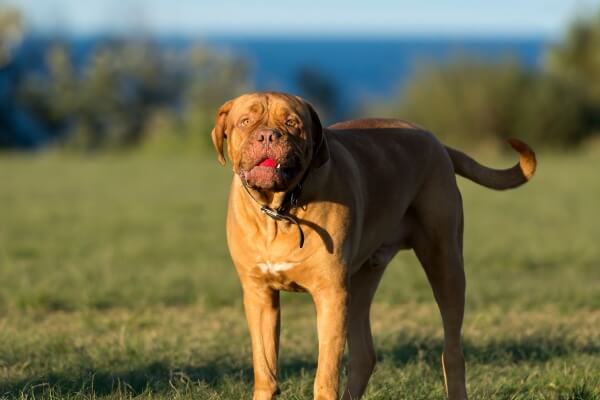
Height: Up to 27 inches
Weight: Up to 110 pounds
Canine Characteristics: Affectionate, loyal, protective
An example of poor genetic breeding, the Dogue de Bordeaux (DDB), was almost non-existent after WWII when just a few pups were bred to reintroduce this now popular breed. The lack of genetic diversity has led to this Mastiff-style dog inheriting many genetic disorders.
Life doesn’t start easy for this breed. The stillborn rate of Bordeaux pups is higher than many other canines. And, many are born by C-section due to their large heads not fitting through the pelvis.
The brachycephalic nature of the French Mastiff — a broad and short skull, which gives them a flat face — makes for a breathing disadvantage from birth, with labored breathing putting more strain on their organs. An inability to cope with hot weather places further stress on the heart health of a DDB. Regular cardiac check-ups are recommended for this unfortunate but loveable dog breed that lives the shortest of all canines.
Great Dane — 7 to 10 Years

Height: 28 - 32 inches
Weight: 110 - 175 pounds
Canine Characteristics: Friendly, goofball-like, patient, powerful
The gentle giants of the canine world, Great Danes don’t have a lifespan to match their size — typically living between seven and 10 years. The number one killer for Great Danes is bloat (or gastric dilation), a condition where the dog’s stomach can become twisted, cutting off essential blood supplies to their other organs.
If you already own a Great Dane or are considering getting one, consult with your local vet to learn more about the implications of bloat. With a proper diet and some extra care, despite being a condition prevalent in Great Danes, it can be prevented to a degree.
Cancer, particularly osteosarcoma (bone cancer), can be an issue for Danes, but most of their health problems are caused by their sheer size. This breed is prone to hip dysplasia, leading to lameness or joint disorders. What’s more, as they age, their internal systems struggle to keep up. Hence, cardiac problems are a common cause of death.
Bernese Mountain Dog — 6 to 8 Years

Height: 25 - 27.5 inches
Weight: 80 - 115 pounds
Canine Characteristics: Strong, good-natured (especially with kids), calm
The average life expectancy for a Bernese Mountain Dog has dropped from a reasonable 10 to 12 years to a much lower six to eight years due to their susceptibility to cancer. Histiocytic sarcoma is a particularly rare aggressive form of the disease that affects the bones, skin, and lungs of a dog.
As if cancer itself wasn’t bad enough, aseptic meningitis, an inflammatory disease of the brain, is also very common in Berners. Inflammation of the brain membranes and the spinal cord can be fatal if the disease isn’t treated at the very early stages of development.
Being a very large dog, again, bloat can be an issue, and Berners can also suffer major orthopedic problems such as elbow or hip dysplasia. A congenital heart problem the Bernese Mountain Dog is known to suffer from is subaortic stenosis. This is where the heart valve narrows and obstructs blood flow — not helped by their huge size.
Leonberger — 7 Years

Height: 25.5 - 31.5 inches
Weight: 90 - 170 pounds
Canine Characteristics: Friendly, gentle, patient
The huge Leonberger is quite a healthy bear-like dog until they reach about six to seven years old. Just like many other larger purebred dogs, they can suffer from hip dysplasia, heart conditions, hyperthyroidism (overactive thyroid), and bloat. The Leonberger breed is also prone to two genetic nervous system disorders:
Leonberger polyneuropathy — decreases the reflexes and muscle tone of a dog’s body, resulting in weakness and eventual paralysis.
Leukoencephalomyelopathy — causes a degradation of white matter found in the central nervous system, which can lead to immobility in older pups. Although not life-threatening, most vets would advise you to consider the quality of life of this usually active pup.
Cancer is a serious problem for Leonbergers, especially bone cancers, such as osteosarcoma, which can spread rapidly to other parts of the body. Another potentially fatal disorder is the Von Willebrand disease, where low levels of blood clotting proteins can cause excessive bleeding.
And finally, a common eye problem of cataracts in the Leonberger can lead to vision loss.
Irish Wolfhound — 6 to 8 Years

Height: 30 inches (min)
Weight: 105 - 120 pounds
Canine Characteristics: Courageous, dignified, calm, patient with children
While the tallest dog in the canine kingdom, the Irish Wolfhound isn't one of the dog breeds that lives the longest — reaching eight years old. Their lifespan is much shorter than your average pooch because of their impressive height and genetic conditions.
Irish Wolfhounds are genetically susceptible to bone cancer, a hereditary blood clotting disorder Von Willebrand’s disease, lymphoma, and hyperthyroidism. Plus, a condition known as Megaesophagus means the enlarged esophagus of the Wolfhound often fails to pass food to the stomach, instead regurgitating or passing food into the lungs.
Another large dog whose size is literally killing them, a leading cause of death for Irish Wolfhounds is cardiomyopathy — where the heart muscles become enlarged and can’t contract or pump blood properly.
Like other deep-chested large dogs, bloat can also be a problem. But the Wolfhound also suffers from liver diseases such as hereditary intrahepatic portosystemic shunt, which can lead to bleeding in the stomach.
Neopolitan Mastiff — 7 to 9 Years
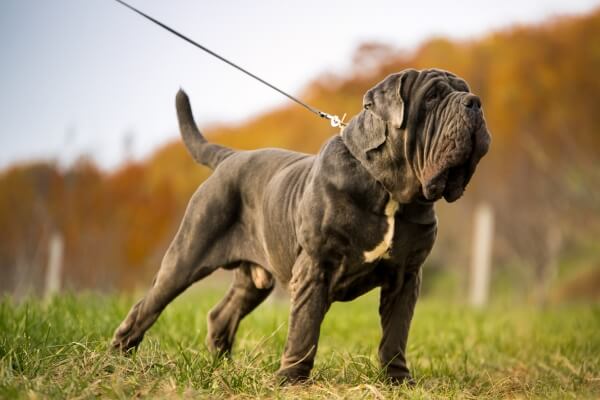
Height: 24 - 31 inches
Weight: 110 - 150 pounds
Canine Characteristics: Powerful, dignified, guardian-like
Like the shortest lifespan dog, the Dogue de Bordeaux, the Neapolitan Mastiff is another brachycephalic breed that suffers from breathing problems, especially when subject to higher temperatures. Their average lifespan, however, is somewhat higher at seven to nine years.
Despite the breed’s impressive wrinkles and loose skin, most Neopolitans don’t suffer from skin issues. Yet, they do suffer with their eye health, including a condition known as ‘cherry eye,’ where the tissue at the corner of those sunken eyes can become red and inflamed. In most cases, there is no permanent damage, fortunately.
With their unique features, the breeding and size have contributed to the shorter lifespan of this charming yet wrinkly pup. Heart conditions like cardiomyopathy, mitral dysplasia, and subaortic stenosis often cause an early demise.
And, Bloat, the sudden life-threatening condition, can be a potential problem, as with many big dogs.Newfoundland — 9 to 10 years
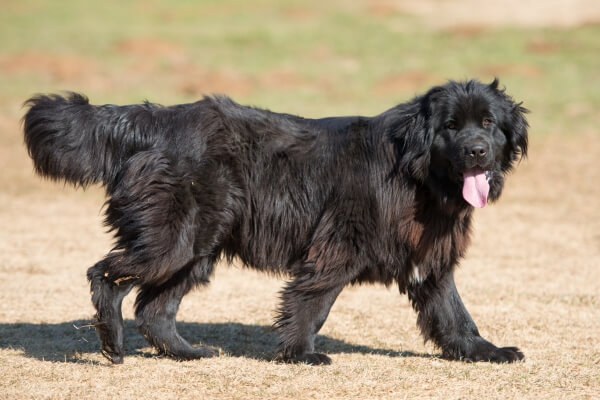
Height: 26 - 28 inches +
Weight: 100 - 150 pounds
Canine Characteristics: Sweet, patient, natural affinity with kids
One of the world’s largest canines, these big brown fluffy dogs just love children but it can be heartbreaking when their beloved playmate goes over the rainbow bridge so young. As you would expect from such a large pooch, they don’t live on average much past 10 years old.
Although they aren’t a brachycephalic breed, they can experience health problems in hotter temperatures due to their famous thick, heavy coats. Yet, heart issues are the main problem for the Newfie because of their incredibly large size — subaortic stenosis is the most serious, being an inherited disease causing the condition and possible heart failure.
Diseases to the musculoskeletal system can be very common in Newfoundlands, particularly abnormal growth of the bones in their front legs, causing elbow dysplasia and lameness of the limbs. Other inherited conditions include kidney stones, cataracts, and possible epilepsy. To make matters worse, Newfies are sensitive to anesthetics, making surgery difficult.Rottweiler — 9 to 10 Years

Height: 22 - 27 inches
Weight: 80 - 135 pounds
Canine Characteristics: Loyal, affectionate, confident guardian
The Rottweiler may enjoy the reputation as the toughest dog on this list but still only has a relatively short lifespan of nine to 10 years.
Cancer is the most common cause of death for Rottweilers, who are particularly prone to bone cancer or lymphomas of some kind. Once diagnosed, the prognosis tends to be quite poor. What’s more, be sure to get your pup vaccinated at an early age too — Rottweilers are highly susceptible to another canine-killing disease, parvovirus, than many other breeds.
Subaortic stenosis can also be an inherited heart health issue. Plus, as larger pups, they’re also likely to suffer from the genetic disease hip dysplasia. And, if life wasn’t bad enough for your poor Rottie, they can also inherit progressive retinal atrophy, a serious eye condition that can eventually result in blindness.Saint Bernard — 8 to 10 Years
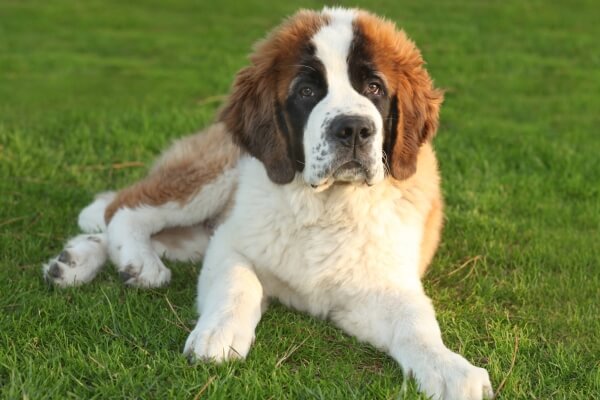
Height: 26 - 30 inches
Weight: 120 - 180 pounds
Canine Characteristics: Playful, inquisitive, charming
With a life expectancy of eight to 10 years, the adorable Saint Bernard is one of the world’s most-loved dog breeds but comes with a myriad of health problems, such as heart disease, cancer, and epilepsy.
With a very rapid growth rate, Saint Bernards can be prone to very serious orthopedic issues such as hip or elbow dysplasia, panosteitis — painful inflammation of the bones aka growing pains, and Wobblers syndrome, a neurological disease that affects the spine of a dog in their neck region.
As they are so large, the Saint Bernard’s heart will have trouble keeping up with their body, and the valves of the heart will thin over time. In addition, Bernies are susceptible to epilepsy, which causes seizures and abnormal behavior. Entropion, where the eyes roll inwards, can be another issue for these lovable mountain rescue pups.
Bulldog — 8 to 10 Years
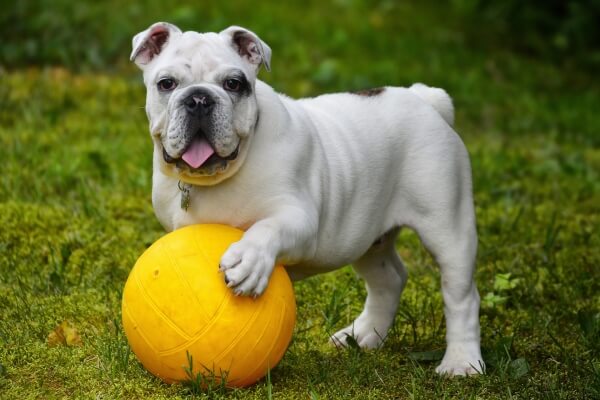
Height: 14 - 15 inches
Weight: 40 - 50 pounds
Canine Characteristics: Friendly, courageous, calm
The only medium-sized dog on our list is the English Bulldog, who, despite their short stature, makes up for it in bulk. With a lifespan of about eight to 10 years, Bulldogs have inherited most of their health problems from poor breeding practices.
As a brachycephalic breed, Bulldogs have a short or ‘flat’ snout, which causes breathing difficulties, especially in hot and humid conditions. Plus, heat stress is another issue — this breed should never be left outside in warm weather.
Unethical breeding means they have compromised immune systems — they’re particularly prone to cancerous diseases when older, such as lymphoma and mast cell tumors.
Unfortunately, the Bulldog is in danger of becoming extinct due to human preferences for a flatter head, skin folds, and child-like qualities in their pups. The short, stumpy shape of a Bulldog can lead to joint problems like hip or elbow dysplasia, while the curved spinal vertebrae of a pup known as hemivertebrae can cause damage to the Bulldogs’s spinal cord and disability.Final Thoughts
You may like to think of your pup enjoying a long, healthy life by your side, surrounded by the love of your family. However, the sad fact is their lives can be woefully brief when compared to their owners.
A shortest living dog breed, like the French Mastiff, may be lucky to reach eight years old, although remember all the numbers we’ve quoted are average lifespans. Understanding the health issues these breeds are prone to and how to potentially treat them may enable you to add a couple of years to their ever-so-short lives.Dog Breeds With the Shortest Lifespan FAQs
Can Small Dogs Live 20 Years?
Although the average lifespan of a typical dog is 12 to 15 years, many smaller breeds, such as Yorkshire Terriers, Chihuahuas, and Toy Poodles, can live much longer — averaging 20 years.
What Are the Small Dogs With Shortest Lifespan?
Small dogs can also develop many of the same life-threatening diseases as larger pups. They can also be more prone to defects at birth, including:
Luxating patella.
Intervertebral disc disease.
Mitral valve disease.
Small Brachycephalic pooches, such as the French Bulldog or Pug, can suffer from severe breathing disorders. These breeds have an average lifespan of just 10 to 12 years.
What Is the Oldest Living Dog In The World?
The oldest dog in the world lived 31 years and 165 days before passing away on 20th October 2023. Bobbi, a purebred Rafeiro do Alentejo, a Portuguese breed, had lived with his owners in Portugal for his entire life. Owner Leonal Costa put Bobbi’s longevity down to the calm, peaceful environment in which he lived.
Which Dog Lives the Shortest?
A recent study found that while the average age of all breeds was 12 years old, the Great Dane and the Dogue de Bordeaux had the shortest lifespans.
What Animal Has the Shortest Lifespan?
The title of the shortest living animal goes to an insect that can be found all over the globe in clean freshwater habitats — the Dainty Mayfly lives for one or two days at most.
Which Dog Has the Longest Lifespan?
Many smaller breeds like a Shih Tzu, Toy Poodle, or Chinese Crested enjoy a life expectancy of up to 18 years. However, the longest lifespan belongs to a Coton de Tulear at 15 to 19 years. To learn more, check out our guide on What Dog Breed Lives the Longest.
